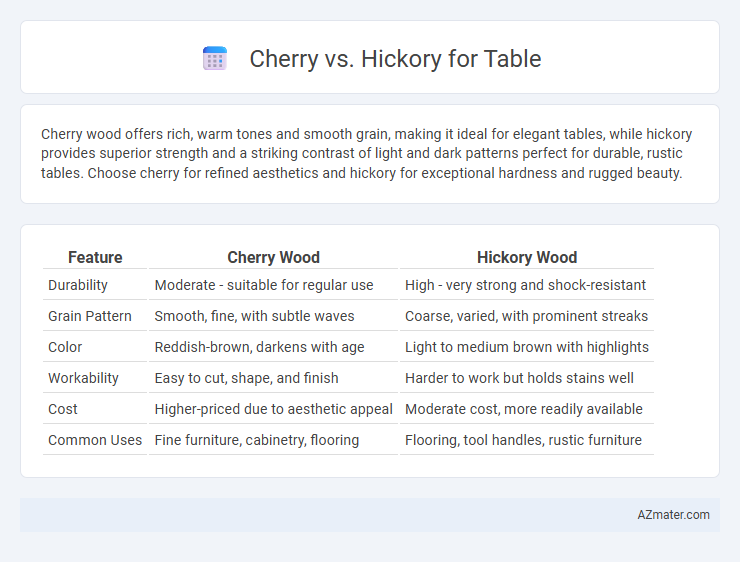Cherry wood offers rich, warm tones and smooth grain, making it ideal for elegant tables, while hickory provides superior strength and a striking contrast of light and dark patterns perfect for durable, rustic tables. Choose cherry for refined aesthetics and hickory for exceptional hardness and rugged beauty.
Table of Comparison
| Feature | Cherry Wood | Hickory Wood |
|---|---|---|
| Durability | Moderate - suitable for regular use | High - very strong and shock-resistant |
| Grain Pattern | Smooth, fine, with subtle waves | Coarse, varied, with prominent streaks |
| Color | Reddish-brown, darkens with age | Light to medium brown with highlights |
| Workability | Easy to cut, shape, and finish | Harder to work but holds stains well |
| Cost | Higher-priced due to aesthetic appeal | Moderate cost, more readily available |
| Common Uses | Fine furniture, cabinetry, flooring | Flooring, tool handles, rustic furniture |
Introduction: Cherry vs Hickory Table Comparison
Cherry and hickory are two popular hardwood choices for table construction, each offering unique characteristics and aesthetics. Cherry wood is known for its rich, warm reddish-brown hues and smooth grain, which deepens with age, making it ideal for elegant, timeless furniture. Hickory, by contrast, boasts exceptional hardness and durability with a striking contrast of light and dark tones, providing a rustic and robust appearance suited for high-traffic use.
Wood Characteristics: Cherry and Hickory
Cherry wood is prized for its smooth texture, rich reddish-brown color, and fine grain that deepens in hue over time, making it ideal for elegant tables with a warm, classic appearance. Hickory, by contrast, offers exceptional hardness and durability, featuring a distinctive, varied grain pattern with contrasting light and dark streaks that create a rustic and robust look. Both woods resist warping and provide strong structural integrity, but cherry's softer feel and uniformity complement refined designs, while hickory's toughness suits heavy-use, rustic furniture.
Appearance and Color Differences
Cherry wood showcases a rich, warm reddish-brown hue that deepens and develops a natural patina over time, creating an elegant and classic appeal for tables. Hickory features a more varied color palette, ranging from creamy white to medium brown with contrasting darker streaks, offering a rustic and dynamic visual texture. The smooth, fine grain of cherry contrasts with hickory's pronounced grain and knots, making each wood choice distinct in both appearance and color characteristics for furniture design.
Durability and Hardness
Cherry wood offers moderate durability and a Janka hardness rating of about 950, making it resistant to wear and suitable for everyday use in furniture like tables. Hickory ranks higher in hardness, with a Janka rating around 1820, which makes it one of the toughest domestic hardwoods, providing superior resistance to dents and scratches. The increased durability of Hickory makes it ideal for tables that require heavy use and long-term wear resilience.
Workability and Craftsmanship
Cherry wood offers excellent workability due to its fine, straight grain and smooth texture, allowing craftsmen to achieve detailed carving and a polished finish with ease. Hickory, known for its toughness and density, demands more effort during cutting and sanding but delivers exceptional durability and a robust feel. The choice between Cherry and Hickory depends on the balance between ease of craftsmanship and the desired hardness for table construction.
Cost and Availability
Cherry wood is generally more expensive than hickory due to its rich color and smooth grain, which are highly sought after for premium furniture. Hickory is more readily available and typically more affordable, making it a popular choice for budget-conscious buyers seeking durability. Both woods offer excellent strength, but cost and availability often drive the decision when selecting materials for tables.
Maintenance and Longevity
Cherry wood offers moderate maintenance with a smooth surface that benefits from regular dusting and occasional polishing to maintain its rich reddish-brown color, while being prone to minor scratches and darkening over time. Hickory wood provides exceptional durability and longevity, requiring less frequent upkeep due to its dense grain and natural resistance to wear, making it ideal for high-traffic tables. Both woods can be preserved effectively with periodic sealing, but hickory's hardness ensures superior resistance to dents and impacts, extending the lifespan of furniture pieces.
Environmental and Sustainability Factors
Cherry wood is valued for its renewable growth and moderate carbon sequestration, making it a sustainable choice for tables when sourced from responsibly managed forests certified by organizations like FSC. Hickory offers durability and hardness, but its slower growth rate can result in higher environmental impacts if not harvested sustainably. Selecting either wood requires prioritizing certified suppliers to minimize deforestation and support ecosystem balance in table manufacturing.
Best Uses for Cherry and Hickory Tables
Cherry tables excel in fine furniture and formal dining settings due to their smooth grain and rich, warm reddish tones that darken elegantly over time. Hickory tables are best suited for rustic, farmhouse, or high-traffic areas because of their extreme hardness, durability, and striking color contrasts between light sapwood and darker heartwood. Both woods provide long-lasting beauty, with cherry favored for refined aesthetics and hickory prized for robust, casual applications.
Which Wood is Better for Your Table?
Cherry wood offers a smooth texture and rich reddish-brown hue that deepens with age, making it ideal for elegant, warm-toned tables. Hickory is known for its exceptional hardness and durability, featuring a striking contrast of light and dark grains that add rustic character and resilience to heavy-use tables. Choosing between Cherry and Hickory depends on desired aesthetics and table usage, with Cherry best for refined beauty and Hickory for robust longevity.

Infographic: Cherry vs Hickory for Table
 azmater.com
azmater.com